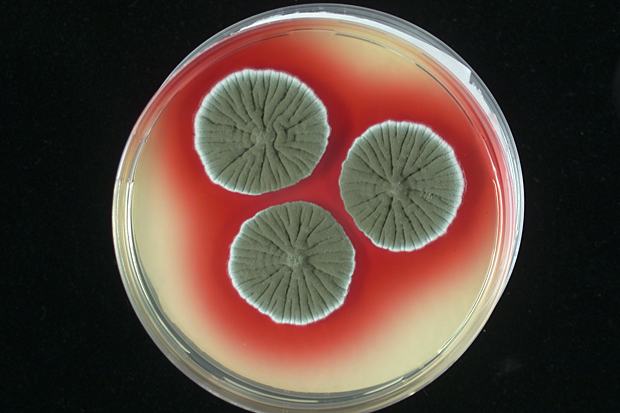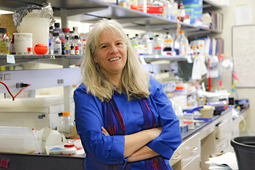Researchers discover drug-resistance mechanism
Information could help in design, manufacture and use of drugs in the future
 Photo/Kristian Fog Nielsen, The Technical University of Denmark
Photo/Kristian Fog Nielsen, The Technical University of DenmarkThe mold Penicillium brevicompactum produces chemicals such as mycophenolic acid that are toxic to other microbes
 Photo/Mike Lovett
Photo/Mike LovettProfessor Liz Hedstrom
Antibiotics are used for everything from squelching strep throat to suppressing the immune system after an organ transplant. Many antibiotics are produced by molds similar to those found on a slice of bread or Roquefort cheese. Penicillium molds are best known for making penicillin, but also produce the not-so-famous mycophenolic acid, a billion-dollar drug used to ward off organ rejection.
However, mycophenolic acid also poisons most microbes, which has had scientists wondering how molds that produce mycophenolic acid can grow in its presence. This general problem is only understood in a few cases. Understanding how some microbes resist high concentrations of antibiotics is important to designing new drugs and deciding how and when to prescribe existing drugs.
Xin Sun, a Ph.D. student in Biology Professor Liz Hedstrom’s laboratory, together with Bjarne Gram Hansen of the Technical University of Denmark, got down to the molecular level to unearth that answer for mycophenolic acid production. Their research was recently reported in The Journal of Biological Chemistry and the Biochemical Journal.
Every drug has a target — in this case a protein to which the drug binds, blocking its normal function. In the case of mycophenolic acid, the target is the protein IMPDH, an enzyme found in every organism. The faster an organism is growing, the more IMPDH it needs. When an infection occurs, immune cells need to grow, so they produce more IMPDH.
Unlike most microbes, Penicillium have two copies of IMPDH.
“What Xin Sun did was to show that this second IMPDH is in fact resistant to mycophenolic acid,” says Hedstrom. “What was puzzling is that you’d expect a change in the drug binding site, but here the drug binding site is identical in both sensitive and resistant targets. Instead, the underlying function of the second IMPDH has changed in clever and sophisticated ways so the drug is no longer effective.”
These findings also provide new insights into another scientific mystery, how antibiotic production evolved in the first place. The team hypothesizes that Penicillium molds gained the second IMPDH through mutation (duplication), which allowed them to make small amounts of mycophenolic acid. Over time, the second IMPDH evolved to become more resistant, allowing the mold to make more mycophenolic acid.
Categories: Research, Science and Technology






